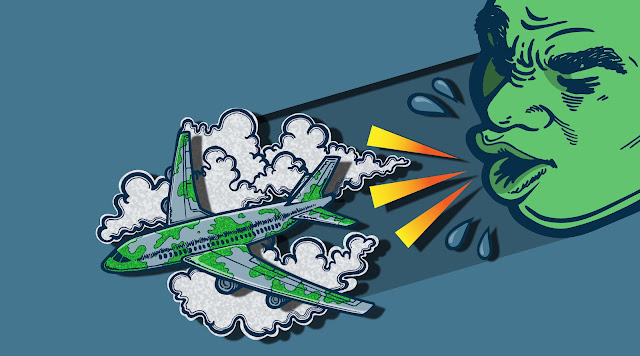How to Battle Germs and Other Health Risks on a Plane
Close quarters, frequent passenger turnaround, and flow rate air make an airplane the ideal breeding ground for germs. According to a study by the folks at Travelmath, who collected bacteria samples on flights at five different airports, the "hot spots" inside the cabin include the tray table which was the worst offender, worse than bathrooms overhead outlet, bathroom flush button and lock, and seatbelt buckle. Another germ magnet is the seat pocket. It should be noted that the drinking fountain buttons at the airport are the dirtiest.
XEM THÊM :
Chia sẻ kinh nghiệm mẹo chơi tài xỉu từ A đến Z
"Airplanes not only create an environment in which viruses thrive," says Nicholas Testa, an emergency medicine physician in Los Angeles.
To stay healthy while flying, follow these guidelines:
Surfaces should be cleaned and sanitized
When a plane spends the night at an airport, the cabin is usually cleaned. Germs can linger between flights because the flu virus can survive for up to 24 hours on hard surfaces. "We actually introduce about 80% of all infectious diseases," says Mark Gendreau, chief medical officer of Beverly and Addison Gilbert Hospitals. "You walk by and unwillingly touch a contaminated surface, which then touches your eyes, nose, and mouth." My favorite fact: humans touch their faces approximately 200 times per day."
Use a hand-sanitizing gel on all commonly germy surfaces, especially tray tables. "When you're settled in your seat, put a few drops on a Kleenex and wipe down the areas you're going to touch," Gendreau advises. Of course, disinfectant wipes are also effective. Wash your hands frequently throughout your flight, especially when you lower the tray table to eat and after using the restroom even if you've already washed them with warm, soapy water. "There have been contamination issues with the water in aircraft bathrooms," he says.
BTW, because of the highly permeable fabric, those seat pockets can be difficult to clean. You might want to keep your own bag underneath the seat.
Assist your immune system
Make sure you've had the flu shot if you're flying during flu season. Influenza spreads through droplets produced when people sneeze or cough, even from as far away as six feet close enough to cause trouble when you're packed into a crowded place. While there is no guarantee that the vaccine will keep you from getting the flu, it will reduce your chances of getting it and, if you do get it, your illness will be less severe.
Select the window seat
With all those potentially sick passengers walking past, aisle seats put you in a more vulnerable position. Furthermore, when going to and from the restroom, people may grab your headrest for support (where, to make matters worse, the hand-washing conditions are not ideal). A study published in Clinical Infectious Diseases examined a Boston-to-L.A. flight. An emergency landing was required due to a norovirus outbreak, which caused vomiting and diarrhea in some passengers. Researchers discovered that passengers in aisle seats, even if they never left their seats, were the most likely to have contracted the virus.
Consider wearing a mask
"Some people are particularly vulnerable to becoming ill, including those whose immune systems are compromised by age or medications," says Martin Cetron, M.D., director of the US Department of Homeland Security's Division of Global Migration and Quarantine (DGMQ). The CDC stands for the Centers for Disease Control and Prevention. Those who take arthritis medication, for example, may be more vulnerable to infection and the consequences of infection. "Wearing a mask in a crowded public setting may not be such a bad idea for those people," Cetron says.
Keep hydrated
"The humidity in the passenger cabin after takeoff can drop to as low as 10%, with the only thing contributing to the humidity being the passengers' breath," Gendreau observes. The dry air can be harsh on the mucous membranes in your nose and airways, which require hydration to function properly. Drinking plenty of water will help to combat the dehydrating effects of flying. Bring a reusable bottle with you. Most airports have filling stations, and you can keep the water coming by visiting the plane's galley once you're in the air.
"Drinking plenty of fluids is especially important if you're on medication," Gendreau says. Some medications, such as blood pressure medications, act as medications.
Extend your legs
The seatback position slows circulation, putting us at risk of deep-vein thrombosis, or the formation of blood clots in the legs. Because most flights are overcrowded for holiday travel, you're more likely to stay seated. Resist the urge to remain stationary and move around the cabin every hour or so. If you don't want to move, Gendreau recommends this exercise to improve circulation: with your feet flat on the floor, rock your heels up and down, up and down. Also, if you are over 60, obese, or have a history of heart disease, varicose veins, or blood clots, consult your doctor before flying, especially if the flight is longer than three hours.
Relax
"The effect of stress on lowering our immune system and ability to fight off germs is one of the most under-discussed negative influences on our health," says DGMQ's Cetron. And, let's face it, even the most fearless traveler's nerves can be frazzled by a day at the airport.
"You're worried about getting to the airport, then navigating to the kiosk, getting your ticket, going through security, and getting to the right gate," Gendreau says. "We'll soon be engaging in anxious behaviors." We'll start rubbing our eyes or biting our nails, which is a total disaster." Do everything you can to eliminate stressors, from arriving at the airport early to having a meditation app on hand.
READ ARTICLES:
Julian Barnes's Arthur and George
7 Ways to Live More Simplicity in a Modern World




Comments
Post a Comment